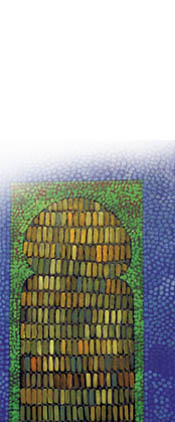
|
 |
This article appeared in The Gulf Today, July 13, 2006.
Canvas of Hemispheres
When East meets West in a Painterly Way, the Result Enriches Both.
By Muhammad Yusuf
There is a lot of confidence in Pakistani artist Lubna Agha’s works. This remarkable artist lives in Boston, U.S.A. and is at the forefront of modern Islamic Art and contemporary Asian Art in the West. Agha is mainly inspired by Muslim cultures stretching from South Asia to North Africa. But her work is not straitjacketed by this specificity. Instead, she is also influenced by Western artistic movements, and her work finds a fine blend between the two. When East meets West in a painterly way, the result enriches both.
Her paintings are defined by their Raphaelic lush lyricism. She does not hesitate to pour on the colours vibrantly and is very Eastern in the use of colour. But she is also strongly individualistic in her concept. Unconfined by Eastern rules of how a painting should be made, her works demonstrate a versatility of shapes and forms. Like objects from an Islamic architectural panorama, her forms can be elongated like a minaret with its typical spire-like pinnacle, arched like the entrance to a mosque, or octagonal like the ceiling forms found in Moroccan riads of yore. But whatever the shape, they exude a serenity that is unique. In the way she chooses her subjects and uses material to manifest them, she also blurs the line between art and craft.
Lubna’s work should be of particular interest to readers of the Gulf because of the strong cultural links that she demonstrates in her paintings, and the idioms and icons she draws upon which should resonate strongly with people with whom she shares her Islamic heritage. These paintings are inspired by what she calls the ‘sublimeness’ of ancient scroll cases and rehels (Quranic bookstands), minarets and spires, fountains reflecting cool pools of water, muqarnas and delicate lattice work. Her canvas and wood paintings are a veritable repertoire of Islamic architecture, created in an art form that is modern and non-representational. The basic construct of her work is the nukta - the dot, the stroke, the dash - that was used with such elegance by artisans and calligraphers of old. The thousand dots that form a single of Lubna’s works combine in a rhapsody of colours to create works that are icons of our heritage – both of our past and our future.
Her work has been described as ‘the revisiting of quite familiar objects of pictorial representation in the Muslim tradition. Re-representing traditional architectural elements, she reworks creative forms from an era of handicraft production. Symbols of architecture, woodcarving, metalwork, textiles, mosaic tiling, carving, miniature painting, Sufi mysticism, not to speak of canvas and wood, are all grist for her brush. But in spite of the variety of imagery, she brings a freshness of vision that is unique to her painted work.
She has exhibited in museums and galleries throughout the world, including Pakistan, Japan, UK, Jordan, Switzerland and the USA. Her work is part of the permanent collections at the Asian Collection at Bradford Museum, UK, National Council of the Arts, Pakistan and the Jordan National Gallery of Fine Arts in Amman.
But the artist is not resting on her past laurels. She is part of a two person show at Niagara Artists' Centre, St. Catharines, Canada. This show is being curated by the South Asian Visual Arts Collective of Toronto, and is preparing to open on the 21st of August. She is scheduled to show at a gallery in Washington, DC in March of 2007. Later in that year, she has been invited to show at the prestigious Research Centre for Islamic History, Art and Culture in Istanbul, Turkey. A show in Pakistan is also in the not-so-distant plans.
The Foundation for Museum of Modern Art in Pakistan is publishing a book on Lubna’s life’s work. The distinguished South Asian art historian and critic, Dr. Marcella Sirhandi, who teaches art at the University of Oklahoma is the author of the book. In perspective, Lubna is a fine example of how an artist with Eastern traditions, western ideals and an inspired mind can win respect in the art world.
|
 |
 |


